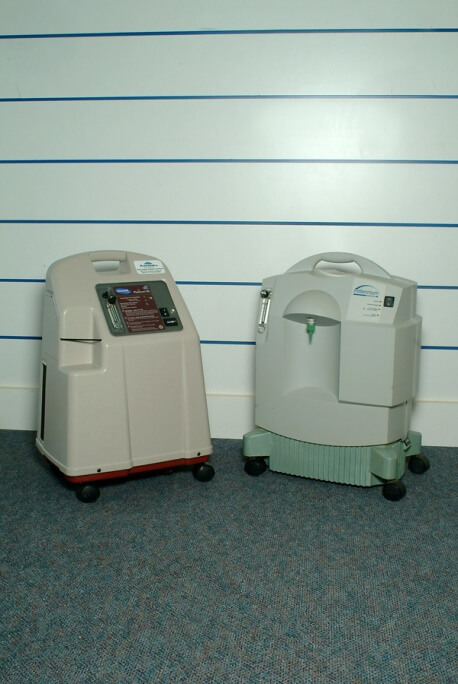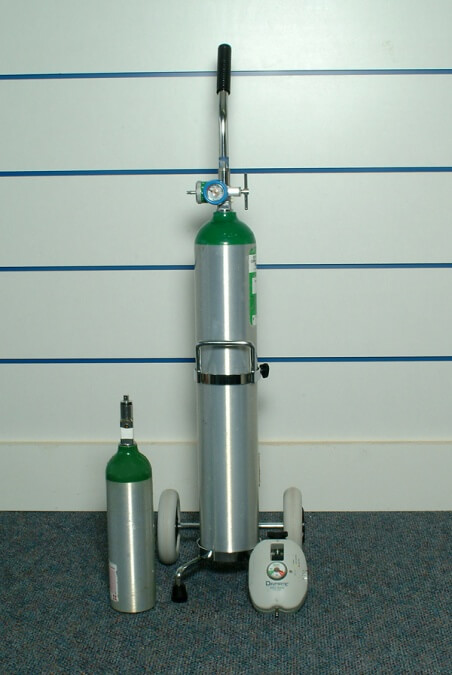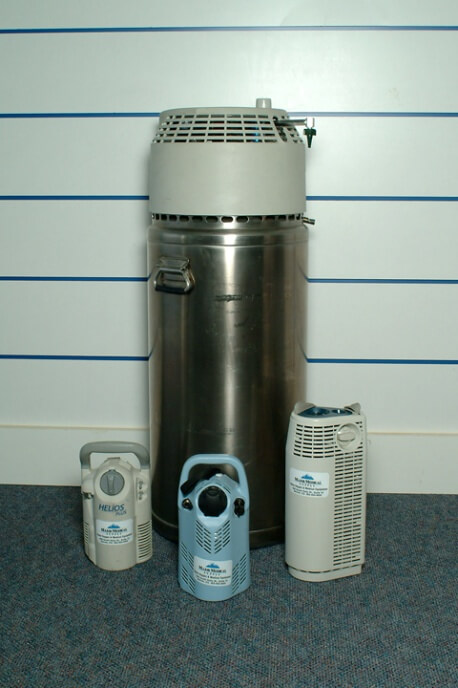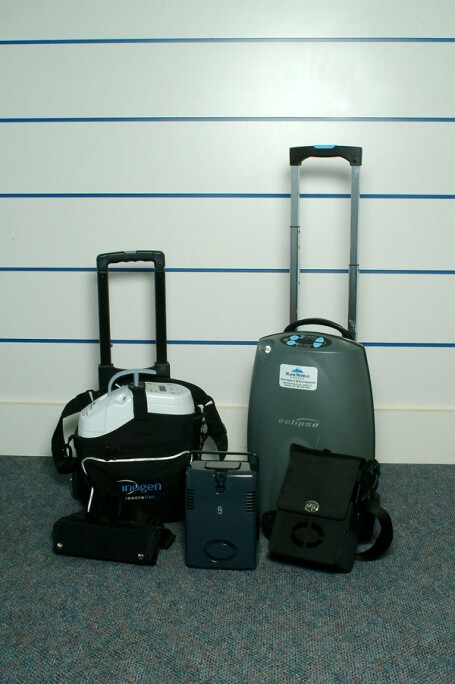On The Go with Oxygen
This information was reviewed and approved by Carol Bair, RRT, Jeff Swigris, DO, MS (6/30/2017).
 People with chronic lung disease may need oxygen therapy. Oxygen therapy is used to normalize the oxygen level in blood during sleep, rest, activity and during acute illnesses in the hospital.
People with chronic lung disease may need oxygen therapy. Oxygen therapy is used to normalize the oxygen level in blood during sleep, rest, activity and during acute illnesses in the hospital.
Oxygen is in the air we breathe and is necessary to live. When we breathe in, oxygen enters the alveoli (air sacs), and passes through their walls into the blood. When the lungs cannot transfer enough oxygen into the blood, supplemental oxygen may be needed.
Oxygen Infographics
What are the benefits of oxygen therapy?
There are many benefits of oxygen therapy. In many adults with chronic lung disease, studies have shown that long-term oxygen therapy has improved quality and length of life. Oxygen can decrease shortness of breath when you are active and allow you to do more.
How will I know if I need oxygen?
It is sometimes difficult for you to know when oxygen therapy is required. If the oxygen level is low in your blood, you may experience symptoms such as: shortness of breath, irritability, morning headaches or ankle swelling. If you notice any of these symptoms, see your health care provider. He or she can review your overall medical condition and decide what treatment you need. Your oxygen can also be low without any symptoms. Just because you feel well doesn’t necessarily mean you don’t need oxygen.
What tests can be done to determine the need for oxygen?
There are two methods to test the oxygen level in the blood: oximetry and arterial blood gases. One or both methods may be used to determine your need for oxygen therapy. Your oxygen level can be measured as a percentage of your blood’s oxygen carrying capacity. This is called oxygen saturation. Oxygen therapy may be necessary if your saturation is below 89 percent. To measure oxygen saturation in your blood, a small clip is placed on the finger or earlobe. This is a simple, convenient, painless way to determine your need for oxygen. This test may be done at rest, during sleep and while you are walking.
The second method of testing is the arterial blood gas. While this blood test is more complex, the results can give your health care provider more information about how your lungs are working. For this test, blood is drawn from an artery in your wrist, and both oxygen and carbon dioxide levels are measured.
How do I get an oxygen therapy prescription?
When the test determines that oxygen is needed, your health care provider will write a prescription for oxygen. The prescription will tell you how much oxygen to use and when to use it. The amount of oxygen you need to use is called the flow rate. You need to understand when to use the oxygen and how much to use during sleep, rest and activity. Remember, oxygen is a medication and should be used only as prescribed. Because oxygen is a medical therapy, it, should be paid for by Medicare and other insurance companies; however, you may have a copay. Check with your insurance carrier to verify your oxygen benefit.
What types of oxygen systems are available?

There are three systems which can supply oxygen: concentrators, compressed gas systems and liquid systems. Each system has advantages and disadvantages. It is important to choose the system that best fits your lifestyle.
Concentrators are commonly used, because they are convenient for both the patient and the oxygen supply company. There are two types of concentrators: Stationary concentrators plug into an electrical outlet and take oxygen from the room air. These systems can add to the monthly cost of electricity, may be noisy and may produce additional heat. You will receive a backup system in case there is a power outage. If you are active, you may need an additional system to use when you go outside your home. Portable oxygen concentrators are oxygen machines that draw in oxygen with the use of a battery, electricity or DC power, for example, the power port in your car. They are smaller and lighter than stationary concentrators. Read more about portable oxygen concentrators.

Compressed gas systems are readily available across the country. Steel or aluminum cylinder tanks, which contain oxygen gas, are available in several sizes.
Liquid systems have two parts — a large stationary container and a portable unit with a small lightweight tank. You can refill your portable unit from the stationary unit. The oxygen supply company will visit at least monthly to refill the stationary unit.
 If your oxygen needs change, the type of system can also be changed. The oxygen supply company should explain and demonstrate whatever system you choose.
If your oxygen needs change, the type of system can also be changed. The oxygen supply company should explain and demonstrate whatever system you choose.
How does the oxygen get from the system to my body?
Oxygen is commonly delivered by a small plastic tube called a cannula. The cannula is placed into the nostrils and delivers oxygen to the airways. Oxygen can also be delivered by a face mask or by a number of other devices.
What is a conserving device?
Your health care provider may consider an oxygen conserving device for you. These devices can conserve oxygen, making tanks last longer. However, conserving devices do not work for every person on oxygen. You will need to be tested to confirm this device will work for you. This can be done by your oxygen company. Ask your health care provider for more information on these devices.
What are some common concerns about oxygen?
You may be concerned about how oxygen therapy may change your lifestyle, how oxygen affects your body and whether oxygen therapy is safe. You may worry that oxygen treatment will prevent you from leaving your home. However, many convenient portable systems are available. In fact, oxygen therapy allows you to be more active by providing the oxygen that your body needs. Oxygen therapy does not cause any harm to your lungs or your body, if used as prescribed. You will not develop an addiction to oxygen. Oxygen therapy is very safe. The only thing you need to remember about safety is that oxygen is flammable: keep your face and your oxygen away from flames. Talk with your health care provider if you have specific safety concerns.
Can I travel with oxygen?

Many people travel while using oxygen. Advance planning is important when considering a trip.
Traveling with Oxygen
What is the cost of oxygen while traveling?
Most insurance companies pay for oxygen in 30-day increments. No other oxygen company can bill your insurance for oxygen, as your local oxygen vendor is billing. If you are taking a trip, you should ask your oxygen company about the company travel policy. Some oxygen companies have national locations and can accommodate your travel. Locally owned oxygen companies may also locate oxygen companies at your destination and may assist in paying the travel oxygen expense for you. You may have to pay the travel oxygen expense out of your pocket. This cost will vary by destination and company policy.
Are there portable oxygen concentrators for travel?

Portable oxygen concentrators are the only delivery devices allowed on airplanes. See below for more information. Compressed gas and liquid tanks are not allowed. There are a number of portable concentrators on the market. Examples of portable oxygen concentrators include:
Inogen One
AirSep LifeStyle
AirSep FreeStyle
SeQual Eclipse
Respironics EverGo.
All these portable units provide a demand flow, or pulsed oxygen delivery. The SeQual Eclipse is an example of a portable concentrator that also delivers a constant flow of oxygen up to 3 liters per minute. No one has made a portable oxygen concentrator that will accommodate over 3 liters of continuous flow oxygen at this time. Pulsed portable oxygen concentrators run on settings instead of liter flow rates. At this time, the highest setting a portable oxygen concentrator will go to is a setting of 6. Please note this is not a liter flow at 6, and you should be tested on your selected portable oxygen concentrator to confirm it is meeting your oxygen needs. The battery time varies per product, as do flow settings. If you would like additional information regarding portable concentrators, or other oxygen systems, contact your oxygen provider.
What should I consider when traveling by air?
Many airlines are allowing the use of portable oxygen concentrators to provide in-flight oxygen. There are a number of these devices approved for airline use, including Inogen One, AirSep LifeStyle, AirSep FreeStyle, SeQual Eclipse and Respironics EverGo. Contact your individual airline to obtain a list of approved devices and required documentation for use of portable concentrators on their airplanes. You will be required to use the battery on the portable concentrator during the flight. Ask your provider to rent or loan you enough batteries to last the duration of your flight. The FAA requires enough batteries to run the concentrator for 150 percent of travel time (including layovers).
What should I consider when traveling by train?
You can bring your own oxygen on board a train in the U.S. at no charge. Amtrak has specific weight requirements that can be obtained on www.amtrak.com, or you can inquire at the time you make your reservation. For travel in other countries, contact the carrier.
What should I consider when traveling by ship?
You can bring your own oxygen on board cruise ships. If you are bringing your own oxygen on board a cruise ship, the cruise ship may not charge you. You may incur a charge if you have to obtain oxygen from an oxygen company that is not affiliated with your home oxygen vendor.
What should I consider when traveling internationally?
There are a number of companies assisting with oxygen for international travel. You will be provided with oxygen concentrators and compressed gas oxygen systems when traveling internationally
The internet holds many resources for travel with oxygen, local and internationally. You also can find resources for support groups on websites provided by the American Lung Association and other medical related websites.
Where else can I get information about using oxygen?
Information about oxygen therapy may be available in your community from your health care provider, your oxygen supply company, your local American Lung Association, a support group of other people using oxygen in your community or LUNG LINE® at National Jewish Health.
National Jewish Health offers a variety of programs that can help people with chronic lung conditions. We offer medical evaluations to determine oxygen needs and how best to meet them, other medical therapies and a team of specialists working together to evaluate your medical condition.
